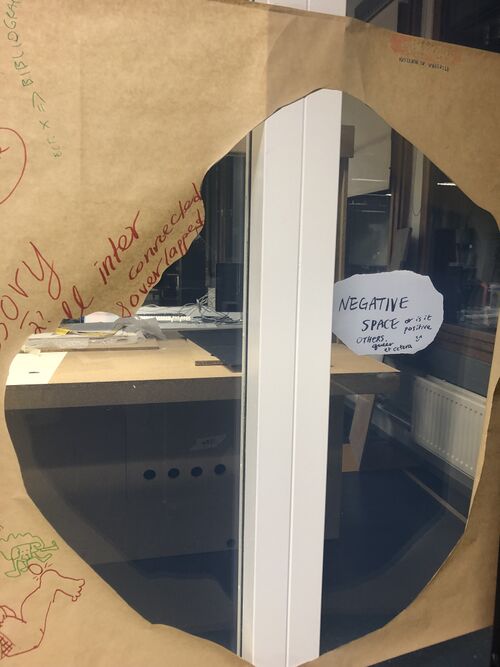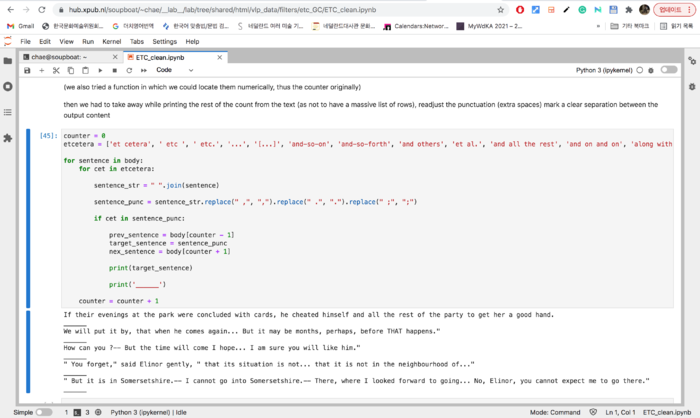Etc Portal to Contamination
etc filter as an entry point to look into rejected space which can be a starting point
An etc filter as an entry point/door to address/look into negative space/rejected space which can be a starting point, yet to be defined.
overview
In the beginning, Gersande's(G) interest in the rejection list was 'rejection as a starting point'
and Chae(C)'s was: 'rejection as a turning point-a trigger for an action/a change/a different direction'.
C was stuck with the word, 'et cetera' because:
1) http://individual.utoronto.ca/bmclean/hermeneutics/foucault_suppl/OT_Borges.htm
2) she was curious to look into what goes under this ambiguous et cetera(and others) boundary.
G's interest started from the work of an AI researcher, [Sennay Gebhreab].
As C and G were learning how to analyze/process txt. files and categorize/structurize using NLTK functions for several weeks, C and G thought what if we shine a light on the usage of 'etc.' which is usually neglected in text and dialogues. Manetta helped C and G to write code that goes through the NLTK corpus('mobydick', 'pride and prejudice', etc.)
Our first result was this: ...(to be continued...)
week 7, 1st of November / Prototyping
During the class, Manetta and Michael introduced us to the concept of corpora and filter. C and G were in a group (cuz we were sitting next to each other(=´∀`)人(´∀`=)) and we started a discussion about our interest in regards to the topic of 'rejection'. G mentioned S--(will be filled in) who focuses on the racial bias in A.I. and the relation between colonialism and technology.(maybe not correct.. G, plz feel free to edit) C talked about her fascination with the 'other' category and et cetera.
etc filter
C and G's intention was:
1) make a et cetera & co filter
2) to give readers a context, not only print/return the target sentence(a sentence that contains etc.) but also print/return previous and next to the target sentence
3) ...(to be continued...)
here are some snippets from G and C's Jupyter notebook.
from nltk.corpus import Gutenberg
gutenberg.fileids()
print(body)
counter = 0
etcetera = ['et cetera', ' etc ', ' etc.', '...', '[...]', 'and-so-on', 'and-so-forth', 'and others', 'et al.', 'and all the rest', 'and on and on', 'along with others']
for sentence in body:
for cet in etcetera:
sentence_str = " ".join(sentence)
sentence_punc = sentence_str.replace(" ,", ",").replace(" .", ".").replace(" ;", ";")
if cet in sentence_punc:
prev_sentence = body[counter - 1]
target_sentence = sentence_punc
nex_sentence = body[counter + 1]
print(prev_sentence, target_sentence, nex_sentence)
print('______')
week 8, 8th of November / Prototyping
Before class
before the prototyping class, G and C had a meeting about what they thought about et cetera. This meeting was a brainstorming session for both of us.
During class
G and C learned how to make input-etc etherpad and output-etc etherpad using API!! C IS SUPER EXCITED ABOUT THIS METHOD.
week 8, 9th of November / Class with Cristina
After having a check-in moment and group discussion with Cristina from 10:00 - 17:30(!!), G and C agreed on the following things:
1) filter etc & co
→ synonyms
→ gate to the negative space
in notebook/logbook (Jupyter-like layout),
2) Run the filter etc & co
→ use the filter to find negative space in content online(things that we wrote in etherpads, NLTK corpora, references gathered by XPUB1 and Cristina, Steve, Manetta, and Michael)
3) yet-to-be-named-publication
→ physical publication
→ annotations/updates can go back to the notebook
→ logbook as intro
→ the instructions
→ negative space waiting to be filled
4) And others(Mainly documentation)
→ track and tracing nomadic publication
→ C and G delivery service, pick-up
→ hand-to-hand
→ last reader/author chooses the next one
...back to number 1), full circle ⥀


